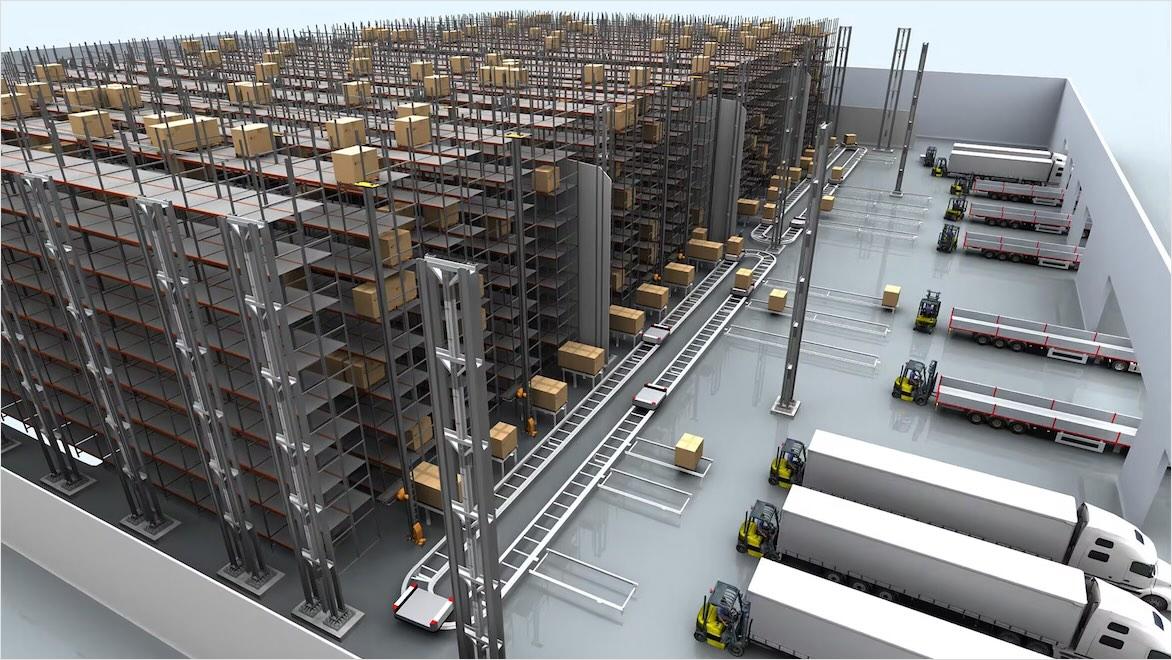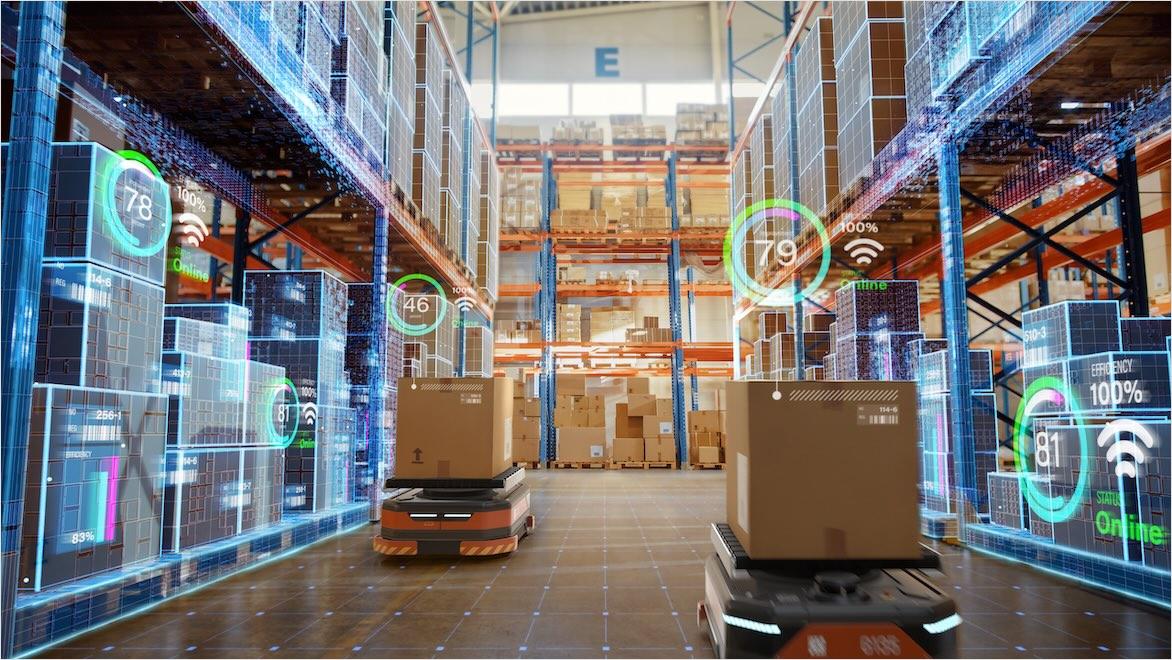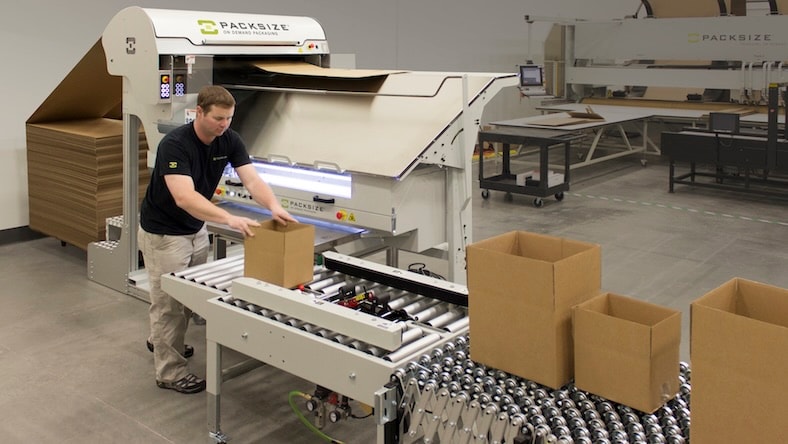& Construction

Integrated BIM tools, including Revit, AutoCAD, and Civil 3D
& Manufacturing

Professional CAD/CAM tools built on Inventor and AutoCAD
Smart warehousing is the evolution of warehouse operations. It achieves supply chain optimization with AI-assisted data analytics, demand forecasting, predictive maintenance, and automated inventory management through advanced robotics, drones, and Industrial Internet of Things (IIoT) devices.
The key features in smart warehousing are technologies that support automation, data collection, and communication.
Automated storage and retrieval systems (ASRS) optimize warehouse space, save time, and reduce warehousing errors. ASRS rely on various types of robotics, including automated guided vehicles (AGVs) for shuttling goods around and drones for scanning and managing inventory levels. Other smart warehousing robots, such as autonomous mobile robots (AMRs), can work productively alongside humans.
Smart warehouse staff can benefit from hands-free, real-time information from wearable technology like extended reality (XR) headsets, smart glasses, and wrist-strap devices. These can deliver picking instructions, smart warehouse navigation paths, and other information and alerts to reduce errors and speed up work.
Radio-frequency identification (RFID) tags help track goods accurately in real time and contribute to the agility and visibility of smart warehouses as part of an automated inventory control system.
The free flow of data throughout manufacturing operations makes a huge impact on smart warehousing, providing visibility that increases accuracy and workflow speed. Warehouse management systems (WMS) monitor and control warehouse operations, automate certain tasks, and help warehouse managers better allocate resources.
A WMS integrated with a robust Industrial Internet of Things (IIoT) network unveils many aspects of smart warehouse visibility, such as inventory tracking, warehouse environmental conditions, equipment status, and maintenance needs.
Fueled by the data generated from a WMS, artificial intelligence (AI) and machine learning (ML) transform manufacturing supply chains and smart warehousing to be more efficient, cost-effective, and responsive.
By analyzing market trends, sales data, economic conditions, and other factors like climate patterns, AI and ML algorithms can forecast product demand, helping manufacturers plan and align their production with market demand, reducing overstock or under-availability. AI and ML data analytics can also align demand forecasts with just-in-time inventory logistics to reduce holding costs and adjust inventory optimization dynamically using real-time data.
Delivery routes can be optimized using AI and ML’s analysis of traffic and weather patterns, as well as previous delivery data. This can reduce delivery times, transportation costs, and fuel consumption. Predictive maintenance—forecasting when equipment needs repair before it fails—based on AI and ML analysis of IIoT data saves costly downtime.
AI drives the computer vision systems that perform automated inventory management, which allows AGVs to perform sorting, picking, and packing in smart warehouses. Intelligent software programs like Autodesk FlexSim run discrete event simulations for designing a smart warehouse layout that minimizes travel time for workers and robots. In general, supply chain optimization with AI creates a more efficient, accurate, and cost-effective smart warehouse by giving managers greater insight into operations, reducing errors, and optimizing inventory and deliveries.
Smart warehousing techniques like supply chain optimization with AI increase operational accuracy and efficiency and contribute to better customer service and cost savings. Benefits of smart warehousing include:
RFID tags and barcodes combine with automated inventory management systems to streamline inventory tracking and reduce errors and losses.
Various smart warehouse automated systems, including ASRS, AGVs, AMRs, and drones can accelerate picking, packing, and shipping processes. Smart warehouse data analytics also help companies respond faster to changes in demand.
Connected data flowing from RFID tags, IIoT sensors, and smart warehouse management software give operational visibility to smart warehouse managers. This informs their decision-making and improves communication with suppliers and customers.
Efficiencies from automation and more accurate inventory management lower operational costs and the cost of misplaced or lost products. Smart warehousing can also make the best use of a site’s square footage.
Smart warehousing enhances customer service with reliable information about availability and delivery time. A smart warehouse can also get products out the door faster, with the most efficient delivery routes and fewer errors in fulfillment.
Realizing the significant benefits of smart warehousing takes an investment of time, brain power, and money, but any business can implement the strategy by breaking it down into a series of steps:
Examine your current warehouse operations such as the flow of inventory storage and retrieval. Identify systems or processes that could be optimized using automation or other smart warehousing technologies.
Pinpoint exactly what you want to accomplish by implementing smart warehousing, such as lower costs, more accurate inventory, or higher customer satisfaction. These objectives will help steer you toward the technologies and solutions to achieve them.
When choosing the right technologies to achieve your goals, consider how they will integrate with your current systems and accommodate any planned expansion in your business. Also consider how integration and training costs might affect the return on investment.
This step may require installing an IIoT network, integrating new software with current software, and reconfiguring your warehouse layout. Advanced planning and preparation can minimize the disruption to your business.
Professional third-party training may be advisable to get your staff up and running as soon as possible. Consider whether the technology you integrate into your new smart warehouse includes ongoing tech support.
Supply chain optimization with AI has the potential for continuous improvement. Smart warehousing systems collect copious data and analyze it for operational insights, suggesting ways to adjust processes for even better results.
The digital transformation to smart warehousing is not just about adopting an array of supply chain optimization technologies, but rather a holistic strategy to future-proof your smart warehouse involving scalability, stakeholder buy-in, upskilling, change management, and cybersecurity.
Protecting your digitalized supply chain from cyber threats is possible with data encryption, firewalls, strict control of user access through methods like multi-factor authentication (MFA), and advanced monitoring tools that detect and address suspicious activities as they occur. Keep all software and IIoT devices updated with the latest security upgrades and schedule regular security audits and risk assessments. As with many aspects of smart warehousing, AI tools can help.
To ensure that your smart warehousing operations can scale with your business, the technologies you install should be flexible and modular, so they’re easily upgraded and/or expanded. Some examples include automation hardware like AGVs and other robotics, as well as cloud-based smart warehousing software like WMS and ASRS solutions that can easily scale to include data from new locations.
Beyond technology, instituting smart warehousing requires a strategy for getting stakeholder buy-in, especially from your organization’s executives, as well as key collaborators or suppliers. This may require convincing proof of the long-term benefits and ROI of smart warehousing—it also may help to start small with a pilot program that can show tangible results.
Employees will need to learn new technologies and stay updated as technology advances. Training sessions and workshops are effective, as are cross-training and knowledge sharing, where employees learn from each other. Online e-learning platforms and resources provide flexible, on-demand learning and are often available from AR and VR devices, making learning inside the smart warehouse convenient.
However you go about implementing smart warehousing, you’ll need effective change management. That can start with clear communication about the planned changes to keep employees engaged and may include a phased implementation of supply chain optimization to give people time to adapt to smaller workflow shifts. As you roll out each phase, a system of employee feedback collection and dissemination can enlighten the workforce and smooth the transition, while also identifying “change champions,” people who are particularly effective and enthusiastic about embracing the new ways of working.
TEOLLISUUSKOPLA OY
This Finnish engineering services company improves customer efficiency in parts procurement through the use of Autodesk cloud PLM solutions like Fusion Manage. Centralized data management has also improved customer collaboration and reduced errors.
PACKSIZE INTERNATIONAL
With right-size, on-demand packaging from Packsize International, businesses can save big on supply chain costs, as well as reduce their carbon emissions. Autodesk AutoCAD LT helps Packsize create smart warehousing environments for its customers.
Image courtesy of Packsize
MAKERSITE
Data and software company Makersite delivers supply chain digital twins that optimize for cost, risk, and sustainability. Its AI maps a customer’s product data, suppliers, and manufacturing methods against a large swath of supply chain and material databases.
Realizing the very tangible benefits of smart warehousing means embracing change. Take, for example, the increasing adoption of robotics and automation that optimize the supply chain with AI. A 2019 prediction from ABI Research that over four million commercial robots will be installed in over 50,000 warehouses in 2025 is coming to fruition. Fortune Business Insights expected continued rapid growth in the global warehouse robotic market, from US$5.3 billion in 2023 to US$13 billion in 2030—a CAGR of 13.8%. These robotic arms, AGVs, drones, and other robotics are automating inventory processes like sorting, picking, packing, and shipping with accuracy, efficiency, and a reduction in workplace accidents. Cobots will be more proficient at working with human counterparts as they integrate large language model (LLM) AI.
Smart warehouses that have an increased reliance on digital systems also need to ensure data security and cybersecurity against threats like counterfeiting, data breaches, ransomware attacks, and more. Blockchain technology can provide an unalterable record of goods’ movement through the supply chain, which can prove responsible sourcing and help goods reach their destinations without interference. Blockchain tech also enables “smart contracts” that can automate agreements and payments within a complex global supply chain. Other cybersecurity measures include creating secure network architectures with robust access control and conducting periodic security audits.
With all of the robotics, cybersecurity, and other smart warehouse technology like IIoT devices in play, companies will need continual workforce training or upskilling, and to hire workers with smart warehouse skillsets like robotics management, cybersecurity best practices, and specialty IT skills for system integration and data analytics. The workforce will be as vital as the technology in successfully integrating evolving technological systems in a coherent, smoothly functioning smart warehouse.
Learn more about supply chain optimization with AI, as well as AI applications in other areas of manufacturing. AI can forecast demand, optimize transportation, and improve smart warehousing by managing inventory, and maximizing the use of warehouse space.
The 3D discrete event simulation software FlexSim makes smart warehousing even smarter with its simulation scenario manager that can make predictions, run experiments, and optimize processes in production environments, including modules for warehousing systems, the supply chain, and automated guided vehicles (AGVs).
Product lifecycle management (PLM) software contributes to supply chain management in part by automating supply chain data sharing, deliverables tracking, and supplier reviews. It also centralizes supplier information, connecting suppliers to a database of BOM (bills of materials) and other data.
Ditch manual updates and emails in favor of this Fusion Manage template specially made for streamlined communication and collaboration with suppliers. Manage supplier deliverables with clear visibility in a dedicated workspace.
The supply chain crisis during the COVID-19 pandemic brought resiliency lessons that are just as relevant today. For example, adopting digital technology that enables big data analytics and predictive modeling with AI can make your supply chain efficient and flexible enough to withstand disruptions, and the associated costs will likely be worth it in time, according to analysts.
Check out the key features of Autodesk Fusion Operations MES software, including smart warehousing advantages like warehouse space management, raw materials tracking, order scheduling, and much more.
Smart warehousing is the evolution of warehouse operations to maximize storage space, speed up and automate retrieval, reduce errors, and lead to higher customer satisfaction. Smart warehousing optimizes the supply chain with AI-assisted data analytics, which can forecast demand and other market conditions and automate inventory management thanks to the data coming from IIoT devices and a variety of smart warehousing robots and cobots, like AGVs, drones, and mounted robotic arms.
AI optimizes a supply chain through multiple advanced capabilities, including demand forecasting, inventory optimization, and delivery route optimization.
AI and machine learning also unlock smart warehousing through AGV robotics for picking and packing, computer vision for inventory management and tracking, and AI-powered analytics for maximizing warehouse space, reducing errors, and improving efficiency.
Key benefits of implementing AI in warehousing include lower operational costs as a result of optimizing inventory levels, delivery routes, and maintenance schedules. AI’s real-time data analysis and automation of certain administrative tasks also streamline processes and support better-informed decision-making.
AI-assisted supply chain forecasting and inventory and logistics management reduce errors in those areas. Supply chain optimization with AI can even lead to higher customer satisfaction by ensuring that deliveries are timely and that products and parts are available when needed.
The future trends in smart warehousing are exciting and many of them are already underway, including:






